Lenovo ThinkBook 13s Review: The MacBook of Windows
Windows laptops come in a variety of shapes and sizes and companies often market different machines to a mix of audiences. Yous have the gaming computers, the creative machines that can bend and twist, the tedious business concern laptops and more than. However, sometimes products can break out of their marketplace categories and pleasantly surprise everyone.
That'south exactly what Lenovo did with its latest business-oriented car. The ThinkBook 13s is, by all accounts, an unassuming laptop. Information technology comes in a boring 'Mineral Grey' color.
On the lid it sports a modest ThinkBook logo in one corner and a Lenovo logo on the opposite side. Inside the laptop's clamshell is a second Lenovo logo on the palmrest. The only other mark is an 'audio past Harman' logo just nether the keyboard.At that place are no stickers, minimal branding and no other markings anywhere on the automobile. Many manufacturers add a lot of stickers and branding to their laptops.
It has an Apple aesthetic and, in many ways, reminds me of the MacBook Pros, which likewise come up almost completely devoid of branding or other marks relieve, of course, the large Apple tree logo and some regulatory symbols on the underside of the device.
But looks are only a minor part of the story and the ThinkBook 13s delivers in many other ways. Performance is higher up and across many other Windows laptops I've reviewed — even ones with the aforementioned or more powerful specs. Further, Lenovo didn't compromise on battery life or throw in a bunch of gimmicky features.
The ThinkBook 13s is a more nuanced and thoughtful approach to laptop design and the attention to detail shows. In many ways, information technology is the all-time laptop I've used this year — high praise for a dull grey business reckoner.
All of the above makes it one of the best Windows laptops I've laid optics on.
Specifications
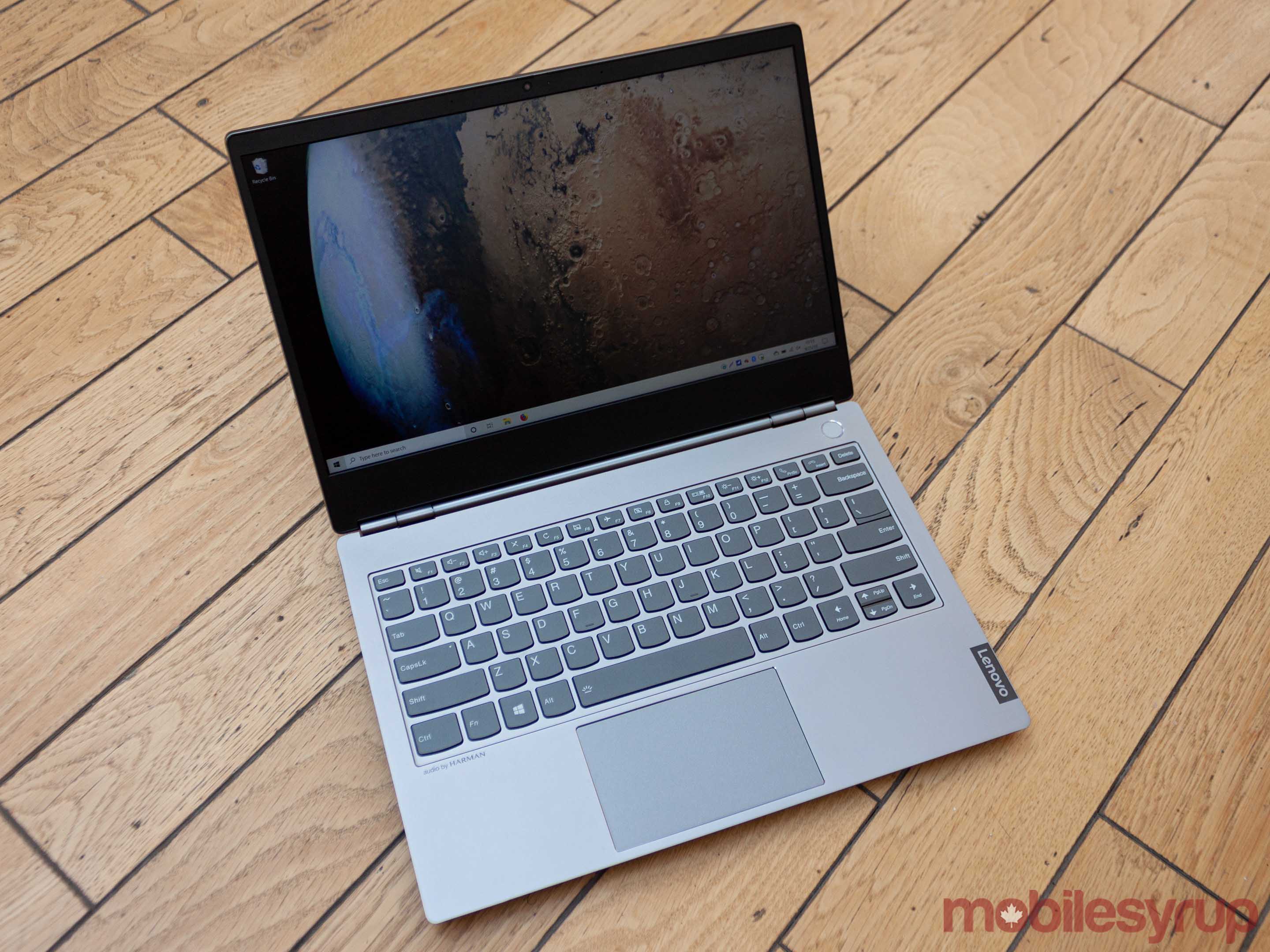
- Display: 13.3-inch Total Hd 1920 ten 1080 pixel resolution IPS anti-glare with Dolby Vision HDR at 300 nits
- Processor: eighth Gen Intel Core i5 8265U (i.60 GHz, 3.90 GHz Turbo Heave) or i7 8565U (1.eighty GHz, iv.sixty GHz Turbo)
- Retention: 4GB, 8GB or 16GB RAM
- Storage: Upward to 512GB M.2 PCIe SSD
- Dimensions: 307.6mm x 216.4mm x 15.9mm
- Weight: 2.95lbs (1.34 kg)
- Photographic camera: 1MP 'Ultraslim' camera
- Operating Arrangement: Windows 10 Home or Pro
- Battery: Up to xi hours (45Wh battery)
- Connectivity: Wi-Fi 802.11 AC (2 10 2), Bluetooth 5.2
- Sensors: north/a
- Ports: 1x USB-C Gen ii, 2x USB iii.1 Gen 1, 1x 3.5mm headphone/microphone jack, 1x HDMI 1.4b
- Graphics: Intel UHD Graphics 620
Beautiful inside and out

There's a lot more to the ThinkBook 13s than you might recall. Information technology'southward pocket-size and light, but tough. Lenovo built this figurer really well — much better than what I typically experience with Windows computers.
There are exceptions to the rule, of course. Microsoft's Surface computers — both the Surface Pro and Surface Laptop — are rigid and well constructed devices. Razr's Blade laptops also tend to have solid build quality. Lenovo'due south ThinkBook 13s joins these computers with its excellent and sturdy construction.
The laptop is solid, more then than about I've used. The just flex I could find was in the display, which would curve slightly when applying pressure.
Lenovo opted for an angular, rugged shape for the body of the ThinkBook and I love it. Information technology gives the computer a unique fashion and an aggressive look without parting as well much from the business organisation aesthetic. The ThinkBook 13s is a laptop that wouldn't expect out of place in a boardroom, but it pulls this off without existence dreadfully banal.

The ThinkBook 13s is too quite thin and clocks in at simply ii.95lbs (1.34kg). It's worth noting there's a slightly bigger version of the laptop, the ThinkBook 14s, which is largely the same. It's a bit heavier at 3.3lbs (1.49kg). While I merely had an opportunity to use the 13s, much of this review applies to the 14s too.
Lenovo paid attention to the lilliputian details too. For instance, the company told me that information technology coated the hinge with indium metal to reduce Wi-Fi interference. Speaking of the hinge, while it doesn't permit the laptop flip all the way around, you can lay the screen flat on a desk if demand be. Another nice bear upon is a built-in physical shutter for the webcam — no more unsightly tape stuck to the top of my laptop screen. You'll want to use this a lot, especially because the laptop's 1MP camera is, frankly, abysmal.
For all it'south attention to detail, Lenovo did miss a few things. For one, it'd be squeamish to run across a small indentation on the bottom of the computer to brand it easier to open the hat. As is, it tin be hard to grip the edge of the hat when trying to open the laptop.
Killer keyboard, mediocre mouse
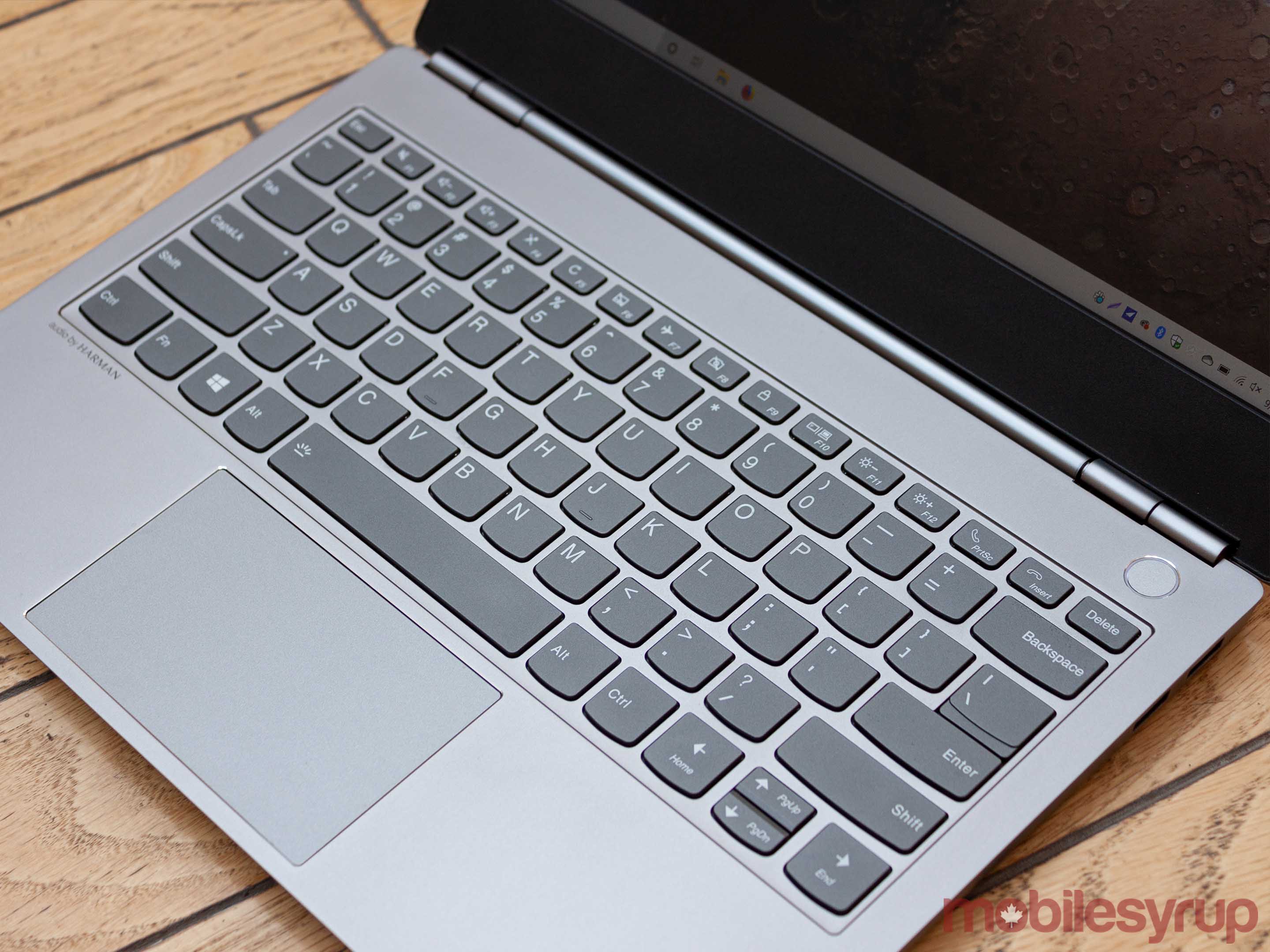
Once yous go the laptop open, at that place are 2 brand-or-break features: the keyboard and mouse. Lenovo's keyboard pick is excellent. The touchpad, on the other hand, is disappointing.
Let's commencement with the keyboard. The ThinkBook 13s sports Lenovo's classic keys, which have a slight rounding on the bottom. While it looks a footling odd at get-go, I found the style didn't severely touch on my ability to type.
In fact, I'd contend the ThinkBook 13s sports i of the meliorate laptop keyboards I've used. Typing is a breeze and the keys are responsive and have a medium travel. I'd put it close to the same level as the Surface Laptop keyboard or the HP Spectre x360, although I think I prefer both of those.
The virtually pregnant gripe I accept with the keyboard is it feels a tad mushy. Information technology lacks the clicky tactile feedback of other keyboards. A notable mention hither would be the new MacBook Air, which I used briefly while working on the ThinkBook review. The Air's keyboard has a distinct audible feedback when typing and feels very well-baked. If the ThinkBook 13s had the aforementioned kind of tactile response, I'd have no issues.
Another small gripe is Lenovo's determination to include 'reply' and 'finish-phone call' buttons for Skype. While this might be a large affair for business users, I found them annoying. They doubled over the Print Screen and Insert buttons, which is fine, but information technology'd be nice if Lenovo picked more useful buttons to add.
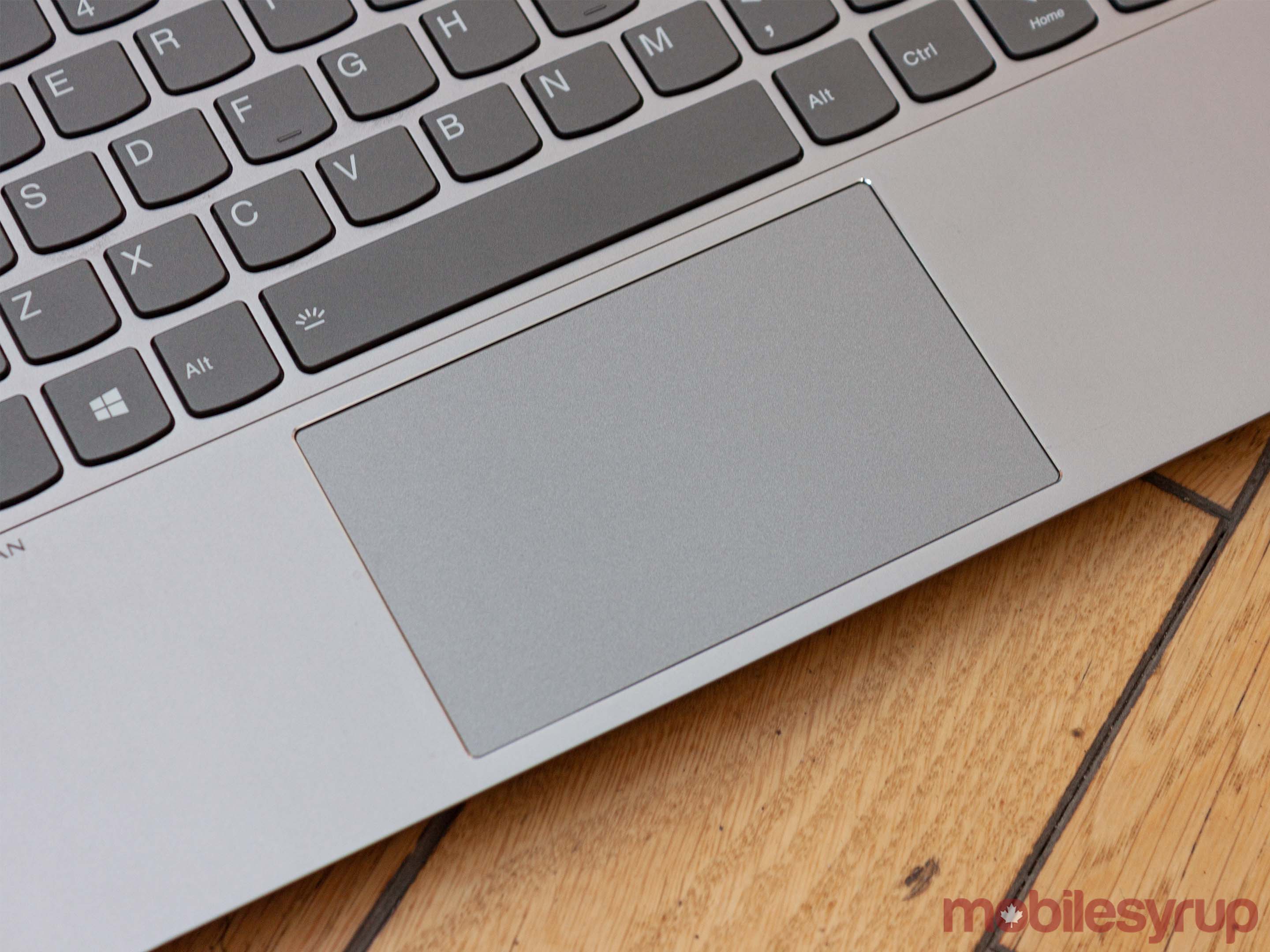
As for the touchpad, the most significant flaw is the size. It'due south an issue that's plagued Windows laptops for some time, but it boggles the mind that Lenovo hasn't thought to improve information technology. Compared to nearly any recent MacBook trackpad, the ThinkBook 13s' offering is laughably modest.
To make the affair worse, Lenovo left close to an inch of unused space above the keyboard. The only affair upwardly there is the power push button/fingerprint scanner (more than on this beneath). However, by moving the power button and pushing the keyboard up and inch, Lenovo could have made the trackpad a off-white fleck bigger.
Beyond that, information technology works rather well. The surface is polish and there wasn't much resistance. The trackpad was also quite tactile, which is a nice touch.
Overall, the touchpad can be best described as cracking for a Windows machine merely disappointing in the scope of all laptops. It'southward certainly usable, and that'southward plenty for well-nigh people.
Going back to the power button for a moment, I have to say that the built-in fingerprint scanner is one of the best I've ever used. Period. It'due south fast. Faster than Apple'southward Touch ID — long lauded as the all-time fingerprint scanner around. It made the experience of opening and unlocking the ThinkBook 13s incredibly smooth. Plus, it works with Windows Hello and so apps like password managers can employ it for authentication too.
Passable screen

Another weak point for the ThinkBook 13s is the display. It isn't a bad display by any means, just I wish it was better.
Lenovo included a 13.iii-inch Full HD (FHD) 1920 x 1080 pixel resolution IPS display with Dolby Vision HDR and 300 nits of brightness. While the specs don't advise much, I did find the laptop was more than than bright enough in about indoor circumstances. If you lot use it outdoors, however, you may discover the screen difficult to see.
Colours on the brandish were too fine. They were accurate and never looked overblown or washed out. Plus, the panel has an anti-glare coating and features a wonderful matte look that is really highly-seasoned. Viewing angles are skilful as well.
But the resolution is where the picture suffered the near. At this display size, 1080p is passable — like offerings with 4K displays have for more pixels than y'all need at that screen size. However, for my pixel-peeper eyes, FHD isn't swell. In 2019, a 1440p display would be a great heart-footing that would offer a sharp, crisp image without significantly impacting battery or functioning.
Ultimately, the screen is fine. It gets the chore done and doesn't wait bad. Information technology'd just exist nice to take more pixels.

One other area Lenovo could have improved the display is by better utilizing the space. The side bezels are quite small, and the top is a tad thicker to make room for the camera. All the same, below the display is nearly some other inch of unused infinite.
It would have been fantastic if Lenovo expanded the screen a bit. It'd break the 16:nine aspect ratio, only the actress vertical space would be a blessing when editing documents or scrolling through the web. Microsoft's Surface Laptop is a great case of this with its three:2 display. Sure, you lot get some letterboxing when watching videos, but information technology's an easy tradeoff to make for the actress space when working.
Battery champ
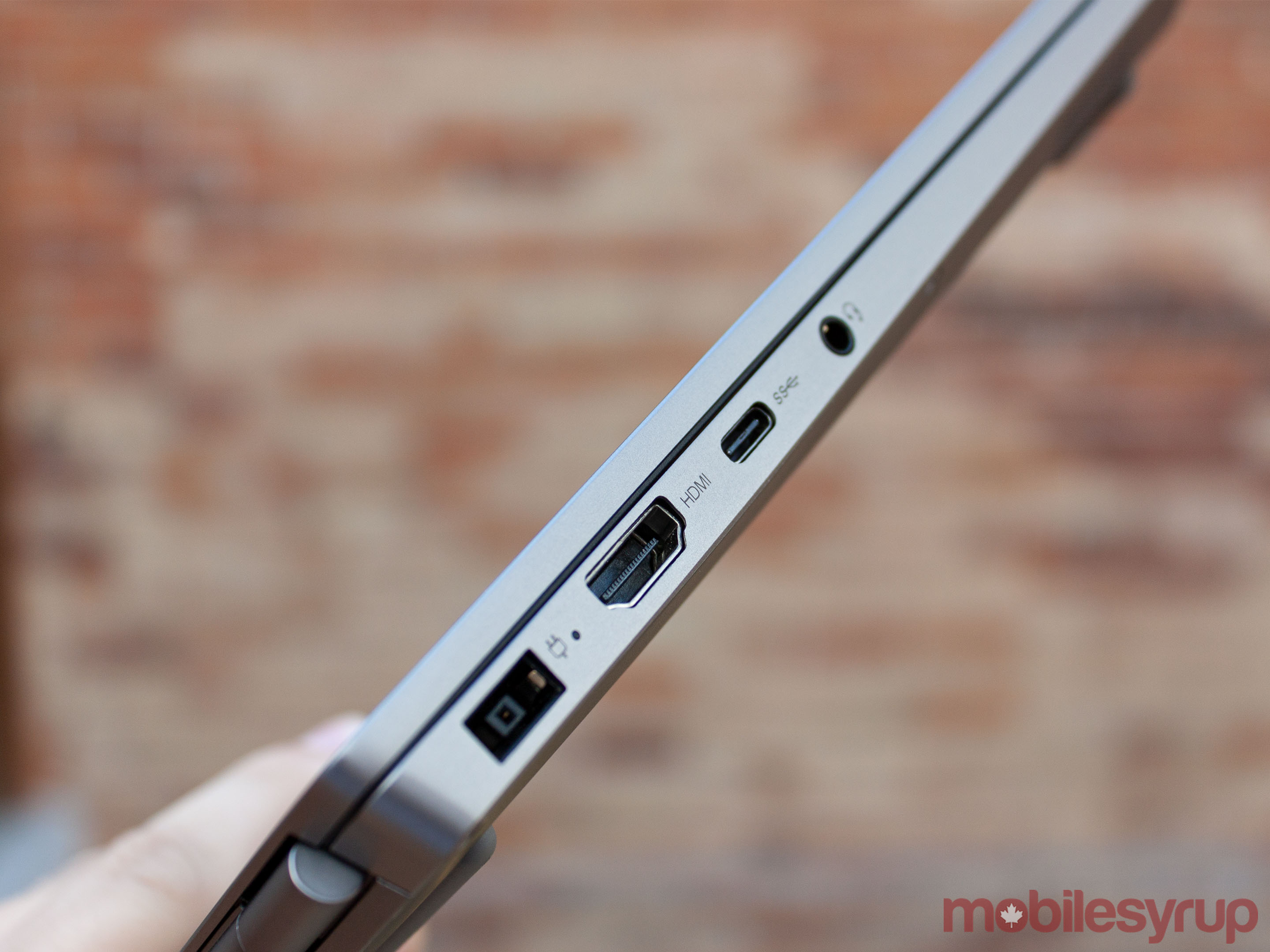
While the FHD display may non be the all-time visually, it does assistance a lot in one area: battery. Lenovo says the ThinkBook 13s can last upwardly to 11 hours based on testing using MobileMark 2014, a battery life metric based on existent-world applications. Even so, real-world apply tends to give a improve indication of battery life.
In my experience, the ThinkBook regularly lasted shut to five hours under a decently heavy workload. I tried it over multiple days with my average work usage — multiple tabs across 2 displays, along with apps similar Slack, Photoshop and email running as well.
Compared to other Windows laptops I've tried, the ThinkBook 13s had impressive longevity. I could stretch the battery much longer by cutting down on open up apps and lowering the screen effulgence if need be.
While the bombardment life was good, I was initially dismayed by the charging situation. Lenovo opted to go with a proprietary port and it charged the laptop quite slowly.

However, that gripe was brusque lived. Lenovo's Vantage app — one of the few pre-installed apps on the device, thankfully — included a setting to enable 'Rapid Accuse,' which dramatically improved the charge speed.
At that place's too a 'Conservation Mode' for those who primarily utilise the laptop while it'southward plugged in. Information technology reduces how much charge the bombardment tin can accept while plugged in to extend the bombardment's life cycle. Lenovo also included a handy tool for checking on the wellness of the battery, which shows a tally of your charge cycles.
Little details go far even meliorate

Overall, the whole experience of using the ThinkBook 13s was splendid. Performance was incredibly good, as I mentioned. In nigh cases, the ThinkBook handled my standard workload better than the HP Spectre x360 did, despite having the same i7 processor and the Spectre sporting double the RAM. You won't be gaming on this laptop, merely it tears through piece of work like you wouldn't believe. Running meaning numbers of tabs, editing photos and other similarly heavy tasks were a breeze for this laptop.
The lack of bloatware was likely a gene in this equally well. The ThinkBook 13s simply had a few apps pre-installed and they never got in the way. Most Windows laptops, including Microsoft'southward ain Surface line, come loaded with pre-installed software, which tin frequently reduce performance.
Lenovo'southward thermal design was impressive as well. Unlike many Windows laptops I've used, the ThinkBook 13s inappreciably kicked on its fans. When it did, it was seldom loud enough to be distracting. The laptop was rarely hot to the touch. It merely always grew warm around the ports when I had the charger, an HDMI cable and a USB-C device plugged in at the aforementioned time.
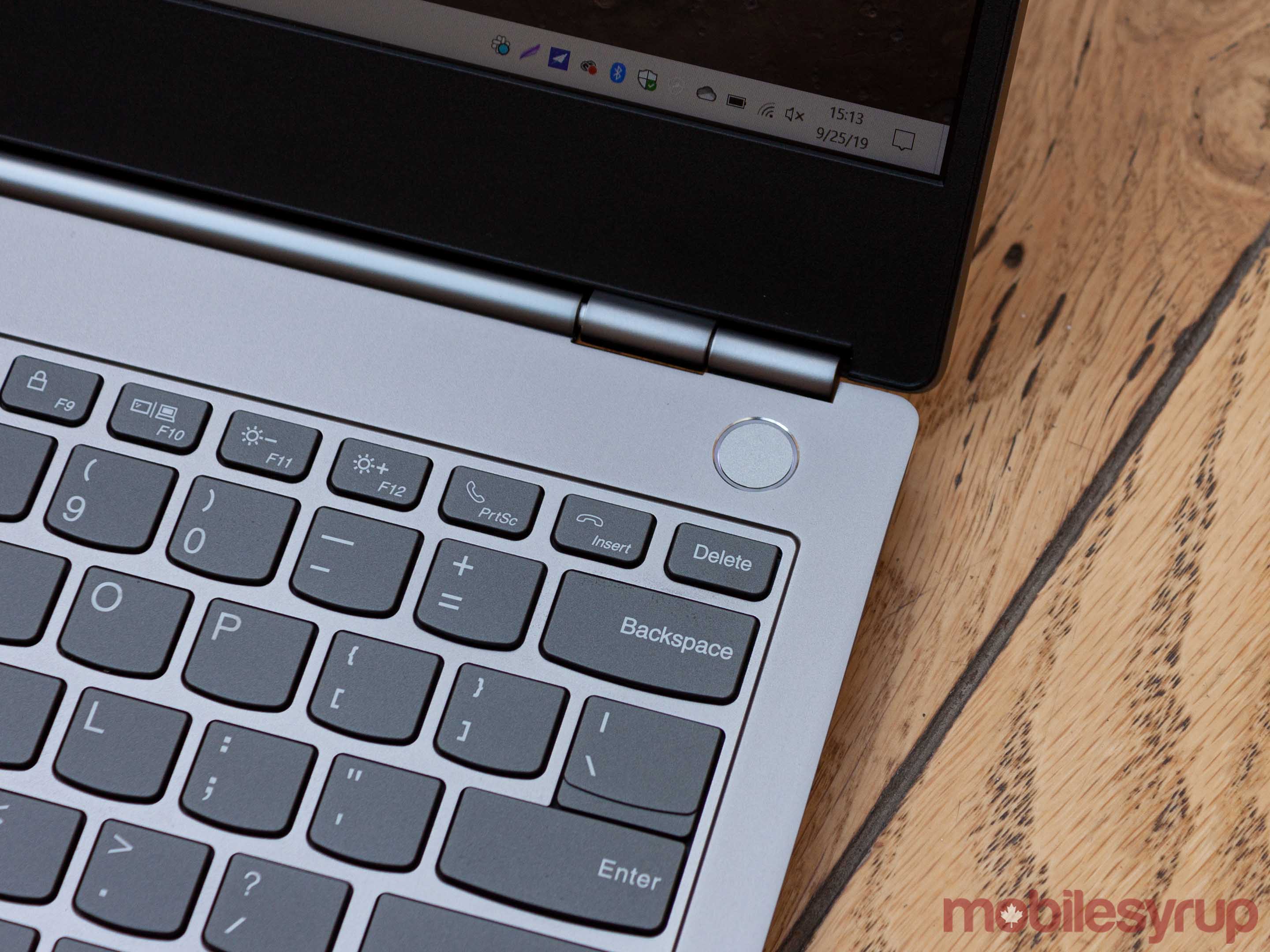
Speaking of ports, Lenovo included a healthy option on the ThinkBook 13s. Along with the ports mentioned above, it features a 3.5mm headphone jack and two USB-A ports.
The charging adapter is a proprietary ane — it looks like a USB-A port but it's actually reversible, which is handy. Nonetheless, I was disappointed it wasn't a USB-C port. With then many other electronics moving to USB-C, it'd be nice to have that equally a charging option so I don't have to comport around as many cables and charging bricks.
Source: https://mobilesyrup.com/2019/10/01/lenovo-thinkbook-13s-review-macbook-of-windows/
Posted by: smithwiting.blogspot.com


0 Response to "Lenovo ThinkBook 13s Review: The MacBook of Windows"
Post a Comment